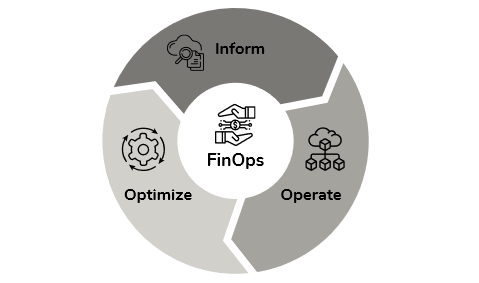FinOps Overview
Get the most value out of your cloud environments through improved visibility, optimized infrastructure consumption, and a culture of financial accountability.
Overview
FinOps focuses on driving financial accountability for all stakeholders across finance, product, and procurement teams to get the benefits of both agile development and forecast-able cloud consumption. Adopting FinOps allows organizations to ensure they are getting the most efficient use of their cloud consumption through repeatable processes, unified key performance indicators (KPIs), and the ability to understand the business value of their cloud spend through unit economics.
FinOps is a solution offering designed to help you develop a culture of financial accountability and realize the benefits of the cloud faster. It accomplishes this through a set of features, tools, and capabilities that enable you to improve predictability, prevent budget overruns, and make more data-driven business decisions.
Some key features and benefits of FinOps include:
- Granular visibility and insights into resource utilization and costs.
- Action-oriented, multi-cloud, multi-dimensional reports including daily/monthly cost view, consolidated charges, charge-back reports, and more.
- End-to-end workflow integration with IT service management (ITSM) tools such as ServiceNow and Jira.
Getting started with CoreStack:If this is your first time using CoreStack, there are some first steps you should take before diving deeper into CoreStack FinOps. Please make sure to read our Getting Started user guide to get help setting up your CoreStack account.
Understand the FinOps lifecycle
The FinOps product is built around the FinOps framework, as popularized by the FinOps Foundation. Part of this framework is the FinOps lifecycle, which is comprised of three phases, illustrated in the graphic below.

The FinOps framework flywheel
The core functionality of the CoreStack FinOps product offering is designed to align to the main phases of this lifecycle: Inform, Optimize, and Operate. By repeating the steps you take as you move through the FinOps lifecycle, you start to get a “flywheel effect,” which allows you to iterate faster and mature as you progress through the crawl, walk, and run stages of adopting FinOps practices.
FinOps lifecycle phases:Inform phase: Costs are identified and allocated by projects, applications, environments, or your organization's unique accountability model by showing teams what they are spending -- and why.
Optimize phase: Take advantage of the dynamic and elastic nature of the cloud by identifying inefficient cloud consumption and selecting the correct resource for the workload through proactive and reactive monitoring, processes, and guardrails.
Operate phase: Leverage automation and policies to overcome the challenges of dynamic cloud services and ultimately gain better control over avoidable cost leakages.
Now that you have a better understanding of CoreStack FinOps and the FinOps lifecycle, you're ready to get started with this solution offering.
Use the links and references below to learn more about the key features of CoreStack FinOps and walk through the steps needed to improve your cost savings and financial accountability with CoreStack.
Get started with CoreStack FinOps
Gain visibility and insights
- Take a FinOps Governance Review
- Gain real-time visibility through cost posture
- Create and view cost reports
- Detect cost anomalies
- Executive dashboards
Optimize costs
-
Usage-based optimization:
-
Rate-based optimization:
Setup and manage administration
Updated 2 months ago
Check out other solution offerings and/or helpful articles.